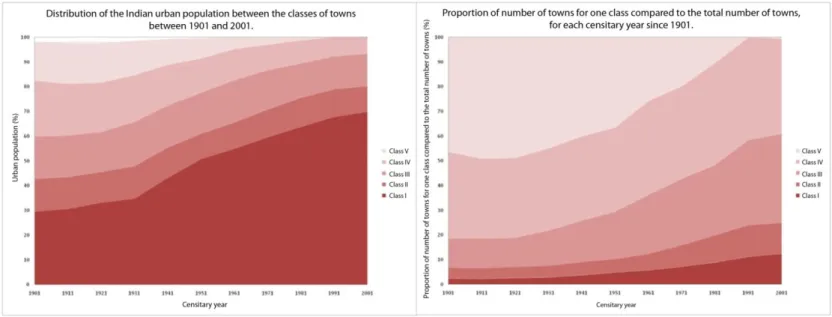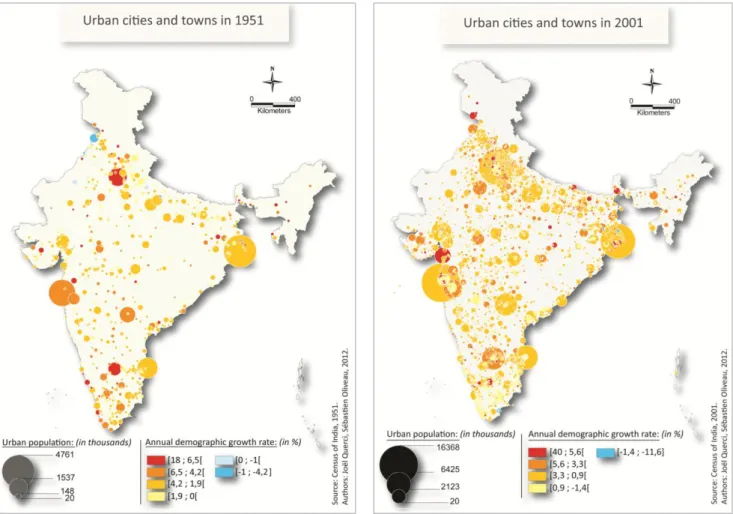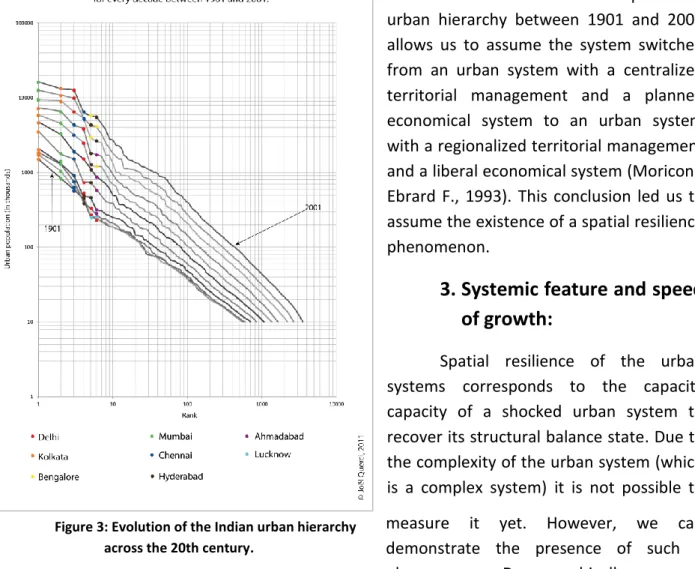HAL Id: hal-01140584
https://hal.archives-ouvertes.fr/hal-01140584
Submitted on 9 Apr 2015HAL is a multi-disciplinary open access
archive for the deposit and dissemination of sci-entific research documents, whether they are pub-lished or not. The documents may come from teaching and research institutions in France or abroad, or from public or private research centers.
L’archive ouverte pluridisciplinaire HAL, est destinée au dépôt et à la diffusion de documents scientifiques de niveau recherche, publiés ou non, émanant des établissements d’enseignement et de recherche français ou étrangers, des laboratoires publics ou privés.
Distributed under a Creative Commons Attribution - NonCommercial - NoDerivatives| 4.0 International License
Growing Indian cities and towns throughout the 20 th
century
Joël Querci, Sébastien Oliveau
To cite this version:
Joël Querci, Sébastien Oliveau. Growing Indian cities and towns throughout the 20 th century. XXVII IUSSP International Population Conference, IUSSP, Aug 2013, Busan, South Korea. �hal-01140584�
1
1
IUSSP - Busan 2013
Theme 7. Internal migration and urbanization.
Session: 07-02 - The growing number and size of cities: causes and consequences”
“Growing Indian cities and towns throughout the 20
thcentury”
Joël Querci, Aix-Marseille University, UMR 7300 ESPACE. : joel.querci@univ-amu.fr Sébastien Oliveau, Aix-Marseille University, UMR 7300 ESPACE.
: sebastien.oliveau@univ-amu.fr There were 35 million plus cities in India, in 2001, and 46 in 2011. Since a few decades, we are attending to a relative take-off of the Indian urbanization rate (16.5% in 1951 and 32.1% in 2011). Indeed, the Indian urban population, in 2011, is more numerous than the population of the USA in 2012. Within the story of the urban India, the historical urban framework had to face two disturbances. The arrival and the departure of the Europeans reorganized the urban framework. The entry of India in the globalization process made an evolution in the urban development logics and forced the country to open, partially, its economy. We observed, since the second half of the 20th century, a quick growth of the number of cities and towns. Assess the causes and consequences of that growing number and size of cities appears essential for the understanding of the future Indian urban society. To address this issue, we will focus on the evolution of the number of towns before analyzing the evolution structure of the urban system. At last, we will consider the link between speed of demographic growth and systemic feature of the Indian urban system.
1. Throughout the 20
thcentury, the evolution of the number of towns:
In India, a town has a minimum population of 5,000, at least 75 per cent of the male main working population engaged in non-agricultural pursuits and a density of population of at least 400 persons per sq. km. (Census of India, 2011). In addition, census office distinguishes six classes of towns and cities: Class VI, less than 5000 inhabitants; Class V, between 5000 and 9999 inhabitants; Class IV : entre 10000 et 19999 inhabitants ; Class III, between 20000 and 49999 inhabitants ; Class II, between 50000 and 99999 inhabitants and Class I, 100000 inhabitants and above (Census of India, 2011).
This typology allows us to assess the evolution of the number of cities and the evolution of the proportion for each class of towns and cities. The figure 1 presents you the evolution of the urban population for each class of cities (at left) and the evolution of the proportion of each of those classes (at right).
2
2
Considering the evolution of the Indian urban population since 1901, we can observe the population of the Class I concentrate the main part of the Indian urban population. Nonetheless, we have to highlight the loss of speed of that class since a couple of decades. This situation can be explained by the wish to develop in priority the small and medium cities since the 1970s. The expected effect is to develop those cities by filtering the migrants to the biggest cities. Moreover, the second central element is the quick growth of the urban population since the 1950s. Indeed, India accessed to its independence in 1947 and built up in federal republic in 1950. This national situation resulted in the internal migration of million peoples and the concentration of poor people in cities (Ramachandran R., 1989). Considering the evolution of the proportion of towns of each class since 1901, the outcomes led us to highlight a stronger growth for the middle cities (classes 2 and 3). This situation reflects the wish to mainly develop the middle cities since the 1970s. These analyses led us to consider that the evolution of the urban development logics transformed the structure of the Indian urban system.
2. The evolving structure of the Indian urban system:
By their politic of urban development, the British reorganized durably the former urban framework. Since their departure, the Indian urban system has modified its urban development logics. Figure 2 presents the Indian cities and towns in place in 1951 (at left) and in 2001 (at right). We represent the annual demographic growth rate (in percentage) for each year and for each city. The intersection of these two variables is crucial for the understanding of the evolution of the urban system. Indeed, this allows visualizing the major population centres by relating them to the annual demographic growth rate. This intersection gives us information about the speed of growth, in terms of urban population, for each city and for a period of ten years.
3
3
In fifty years, the urban logics seems to be contrasted. Actually, in 1951, we observed stronger annual demographic growth rate in towns of Class I. The speed of growth of the major cities stays enough high whereas little and medium cities had a smaller. As we saw previously, the independence of India in 1947 resulted in the concentration of poor populations in the cities which explains this sudden gain of urban population. In the same time, refugees arrived from Pakistan in the North of the country. The refugees from the North West of the Pakistan found refuge in the region of Delhi and in Uttar Pradesh; refugees from the East of the Pakistan found refuge in the region of Calcutta (actual Kolkata) and in the East States of India (Ramachandran R., 1989). The growth of the urban population during 1941 and 1951 appeared more as the result of the migratory balance than the natural balance.
This situation is completely reversed fifty years later. Indeed, in 2001, the situation led us to assume of a progressive resorption of the regional situations of urban primacy identified by the study of the urban hierarchy at the regional level. This situation means significant changes for the urban population: by developing the second and third orders cities, regional framework rebalanced its structure while at the national scale the situation seems to be balanced. Geographers identified, in 2007, the Indian urban system as an ancient system which undergone a disruption (Bretagnolle A., 2009). This change of urban system logics appears more precisely when we look at the Zipf’s rank-size distribution of Indian towns and cities on the 20th century (Figure 3).
4
4
The evolution of the shape of the urban hierarchy between 1901 and 2001 allows us to assume the system switched from an urban system with a centralized territorial management and a planned economical system to an urban system with a regionalized territorial management and a liberal economical system (Moriconi-Ebrard F., 1993). This conclusion led us to assume the existence of a spatial resilience phenomenon.
3. Systemic feature and speed
of growth:
Spatial resilience of the urban systems corresponds to the capacity capacity of a shocked urban system to recover its structural balance state. Due to the complexity of the urban system (which is a complex system) it is not possible to measure it yet. However, we can demonstrate the presence of such a phenomenon. Demographically, we can assume the existence of that resilience phenomenon analyzing the evolution of the annual demographic growth rate. In our case, this method allows us to prove that the Indian urban system tends to a relatively lapping along the century by the resorption of the regional urban primacy situations. The rest of the work will consist in the measure of that resilience phenomenon using exploratory statistics in order to create an index of spatial resilience.
4. References:
BRETAGNOLLE A., PUMAIN D., VACCHIANI-MARCUZZO C., (2009), LANE D., PUMAIN D., VAN DER LEEUW S., WEST G. (Ed.) "The organisation of urban systems", in Complexity perspective in innovation and social change, pp. 197-220.
CENSUS OF INDIA, 2011, Provisional Population Totals Paper 2, Volume 2, online at the following URL: http://www.censusindia.gov.in MORICONI-EBRARD F. (1993), L’urbanisation du monde depuis 1950, Paris, Collection Villes, éd. Anthropos, Economica, 372p. RAMACHANDRAN R. (1989), Urbanization and urban systems in India, Oxford India Paperbacks, 364 p.
Figure 3: Evolution of the Indian urban hierarchy across the 20th century.


